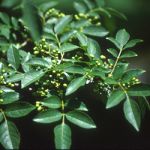| Common Name: |
Sichuan Pepper |
| Other Names: |
Szechuan Pepper, Chinese Pepper, fagara |
| Botanical Name: |
Zanthoxylum simulans syn Z. bungei |
| Genus: |
Zanthoxylum |
| Family: |
Rutaceae |
| Native Location: |
China and Taiwan |
| Cultivation: |
Fertile soil in sun or shade. Remove dead wood (which is prone to coral spot fungus) and cut back in late winter or early spring. |
| Propagation: |
By seed sown in autumn; by root cuttings in late winter. |
| Harvest: |
Leaves (Z. piperitum) are picked during the growing season and used fresh. Bark is stripped in spring and dried for use in decoctions, liquid extracts, and tinctures. Fruits are collected in summer and dried for use in decoctions and liquid extracts. |
| Height: |
3m (10ft) |
| Width: |
3m (10ft) |
| Hardiness: |
Z6-10 |
| Parts Used: |
Fruits |
| Properties: |
A pungent, warming, stimulant herb. |
| Culinary Uses: |
Dry roasted fruits are used whole or ground as a condiment in Chinese cuisine, notably in Chinese five spice powder. |
| Bibliography: |
The Encyclopedia or Herbs by Deni Bown Copyright © 1995, 2001 Dorling Kindersley Limited. pp. 409-410 |

